Hitches and Towing 101
| CHAPTER CONTENTS | |
| 1. Introduction to Towing | 7. Brake Controls |
| 2. Towing Components | 8. Hitch Installation |
| 3. Types of Hitches | 9. Hooking Up |
| 4. Determining Tow Capacity | 10. Tow Bars/Dinghy Towing |
| 5. Selecting Your Hitch | 11. Towing Safety |
| 6. Wiring/Electrical | 12. Preparing Your Tow Vehicle |
Chapter 11
- Towing Safety
When you've got
the correct gear, some practice and confidence, towing can be as easy as
single-vehicle driving. Yet safety should always be your main concern when
you're pulling a trailer. Because no matter how easy and comfortable the
process, the fact is that your towing rig weighs more and doesn't dodge or stop
as easily as other cars on the road. If you observe some simple safety rules and
practices, you can greatly reduce the likelihood of accidents and handle many
emergency driving situations like a pro.
Basic Trailering Safety
Practices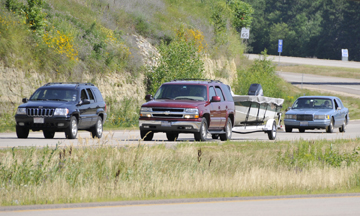
Common
sense is your best friend when it comes to safe trailering, and overconfidence
is your worst enemy.
The fact is, with modern equipment and a
well-prepared trailer and tow vehicle, towing can feel almost as natural as
single-vehicle driving, but you should never drive a trailering rig like a
single car. When towing a trailer, always keep these guidelines in mind:
Load your trailer right - Make sure your trailer's load
is balanced with about 60% of the total weight in front (but not too far in
front) of the axle. Also make sure the load is centered and secured and that the
center of gravity is kept as low as possible.
Hook up
right - Make sure you have followed the procedure for hooking up your
trailer and double-checked all your connections. Make sure your safety chains
are crossed under the trailer tongue and securely connected as shown in Figure
11-1. 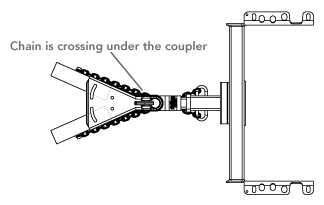
Figure
11-1: Proper safety chain connection
Allow plenty
of stopping and following distance - You need to allow much more
following distance when trailering. Basic physics dictates that even with the
best brakes, it takes longer to stop a big heavy truck and trailer than a small
car. 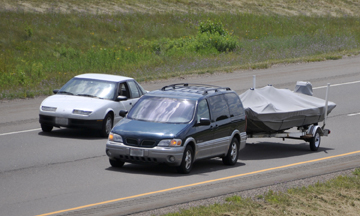 Be
extra careful changing lanes - Changing lanes is a challenge,
especially if traffic in the new lane is moving much faster or slower than you.
You simply cannot accelerate quickly to match traffic, and no one likes to be
cut off. Make sure you've got wide trailering mirrors installed to give you a
clear view of the lane next your tow vehicle and the full length of your
trailer. Unthinking drivers will often "park" next to your trailer and hang
there for miles.
Be
extra careful changing lanes - Changing lanes is a challenge,
especially if traffic in the new lane is moving much faster or slower than you.
You simply cannot accelerate quickly to match traffic, and no one likes to be
cut off. Make sure you've got wide trailering mirrors installed to give you a
clear view of the lane next your tow vehicle and the full length of your
trailer. Unthinking drivers will often "park" next to your trailer and hang
there for miles.
Be patient with slower vehicles -
Passing a slower car should be a rare occurrence when you're towing. You have to
allow many times the distance normally required to pass another vehicle. Passing
on a two-lane road should almost never happen - you should be passing only
vehicles that cannot maintain at least 50% of the posted speed. Better to wait
for a turnout and hope the slower traffic uses it!
Be gracious
with faster vehicles - The best way to get down the road safely is to
be extra courteous to faster traffic. Use turnouts whenever possible, and when a
passing lane comes along, don't speed up to race passing traffic, but rather
slow down just a bit to help people get past you in an efficient manner. Your
stress level will be reduced and you'll contribute to a courteous culture on the
road. Above all, be solid and predictable when someone is passing you. Avoid
sudden acceleration, braking, or maneuvers.
Don't pull in where
you can't see out - It's easy to get stuck with a trailer. You might
pull into a small parking lot and have to perform a complicated backup maneuver
to get out. Better to park across the street or on the road where you can see
your way through.
Be safe with a trailer lock - Trailer
theft is a serious problem. Travel trailers and enclosed car and equipment
trailers are often stolen and pillaged for their contents. Use a coupler lock as
shown in Figure 11-2 when towing, as it also helps prevent your coupler from
coming loose, and use a pintle lock as shown in Figure 11-3 when parked so that
no one can hook up your trailer and haul it away. 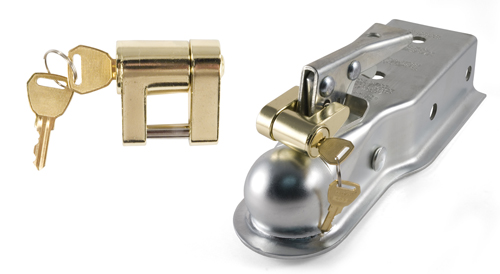
Figure 11-2: Coupler Lock
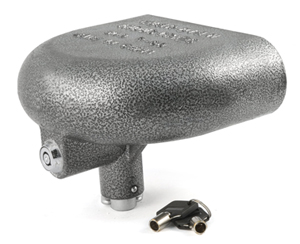
Figure
11-3: Pintle Ring Trailer Lock
How to Anticipate
Problems
The thing that separates truly good drivers from most
others is the ability to see into the future. Luckily, this is something almost
anyone can learn to do. To see the future, just use more of the same skills you
should always use when driving. Follow these guidelines:
Take the
long view - Since it takes longer to go, stop, change lanes, and turn
with a trailer, keep your eyes up and look ahead farther than you normally do.
You can see many problems developing a long ways away. Look through the
windshield of the car ahead of you, if necessary.
Watch traffic
flow - You can frequently identify the drivers who may cause problems
long before they can make trouble for you. Look for the driver who's weaving
through traffic, or who pulls in right in front of a faster car. Keep an eye out
for the driver who can't stay in a lane because he's too busy with his cell
phone, or the 18-wheeler that's about to lose a smoking tire. Give all potential
problems plenty of room, and you can usually do that with just a small speed
adjustment.
Keep an eye out for sway - if an
18-wheeler blows by you like you're chained to a bridge, especially on a
downhill grade, your trailer is likely to be blown around a bit. If you're not
careful, your trailer can start swinging like a pendulum. The answer is to
simply ride the brakes very gently. If that doesn't work, input a little trailer
brake with the brake controller. Just press the button and your trailer will
snap right back in behind your tow vehicle.
Handling Tire
Blowouts
Even if you buy quality tires, you can experience a
flat. By far, the most dangerous flat is on the rear axle of your tow vehicle. A
flat front tire will make your steering feel heavy and unresponsive, but you can
slow down and pull off. A flat on your trailer will pull your car around a
little, but you can still slow down and pull off easily. 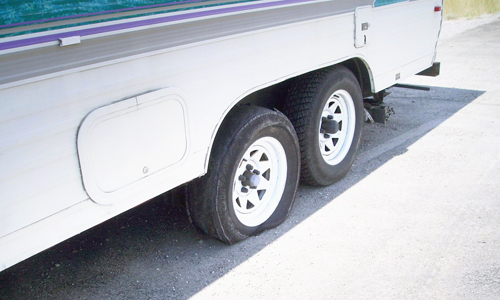
A
flat on the rear of your tow vehicle, however, can make your tow vehicle
difficult to steer predictably, and getting off the gas abruptly can make the
situation worse. If you get a blowout in your back tires, gently ease off the
gas and apply some trailer brake with the controller and find a place to brake
gently and pull off. Smoothness and gentle pedal work will get you to the
shoulder safely.
Towing in Bad Weather
Safe
towing in bad weather requires the same common sense for dry daytime towing, and
even more of it. High winds will blow your trailer around - I've experienced
gusts that pushed my trailer halfway into the next lane! Of course, rain and
snow further reduce your traction and greatly increase your stopping time and
distance. The key to good foul-weather towing is patience and smooth, gentle
driving. Also, be on extra guard for the fellow in a passenger car who should
have no trouble, but always seems to lose control right in front of you!
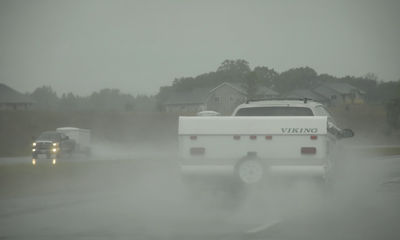
When
You Have to Stop
Part of smooth towing is smooth stopping. Keep
your vehicle and trailer brakes adjusted and your brake controller working
properly - at least 70% of a good stop is in the equipment. Your good sense
makes up the balance. Don't ask your vehicle for a full-force stop every time!
The more you can baby your brakes, the longer they'll last and the better
they'll stop you when you really do need everything you've
got.
Specifically, if you're coming down a long grade, drop your tow
vehicle to a lower gear and take it slow. Use your brakes in brief, firm,
presses, pausing between them to let the components cool. If you smell burning
brakes on a downgrade, it's almost never your own vehicle you're smelling - it's
the people in front of you. Still, if you sense a change in your pedal response
on a downgrade, ease off the brakes and let your gears help slow you down.
Backing up a Trailer
Backing up a trailer at any
time is tricky. Backing up a dinghy car is the most difficult and can be done
only for very short distances. But there are a few basic rules to live by:
- The shorter the distance from your hitch to the trailer wheels, the harder it is to back up in a straight and predictable way. Short trailers swing around with the slightest steering input! Long trailers are comparatively easy to back up.
- Put your hand at the 6 o'clock position on the steering wheel, and the back end of the trailer will go in the direction you move your hand. Use tiny steering inputs - once the back of the trailer starts turning, it will come around fast.
- If at all possible, ask someone to stand behind the trailer to give you directions and be a second set of eyes.
Dos and Don'ts of Safe Trailering
DO
- Pause after 50-100 miles of towing and check all your hitch connections and adjustments
- Observe all speed limits when towing
- Use lower gears and intermittent braking when descending a grade
Allow much greater following and stopping
distances
DON'T
- Become complacent about towing on the highway
- Decide to tow without necessary safety gear, even for short distances
- Forget to use turnouts to let other traffic pass by safely
| << Back to Chapter 10 | Go to Chapter 12 >> |




